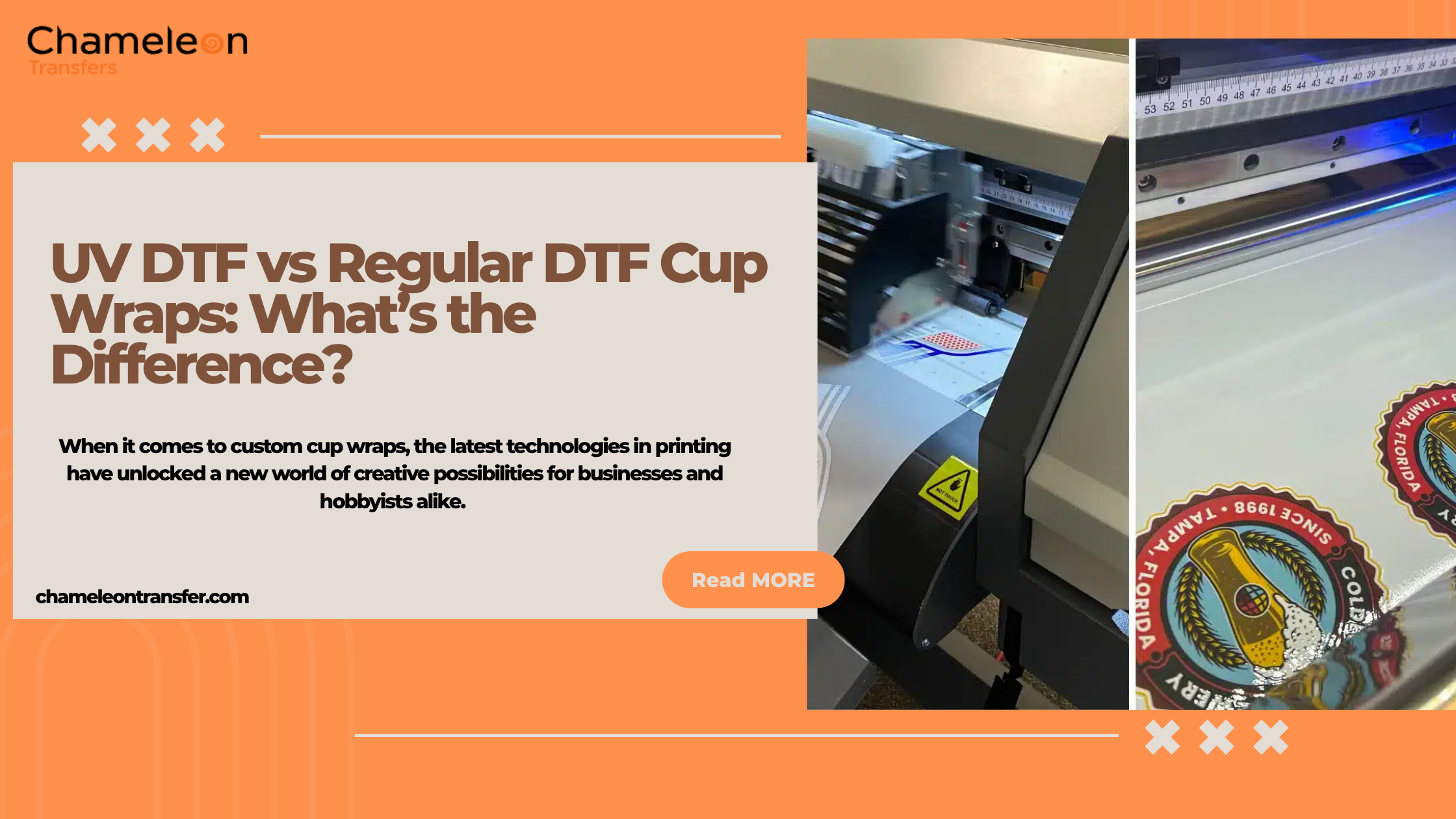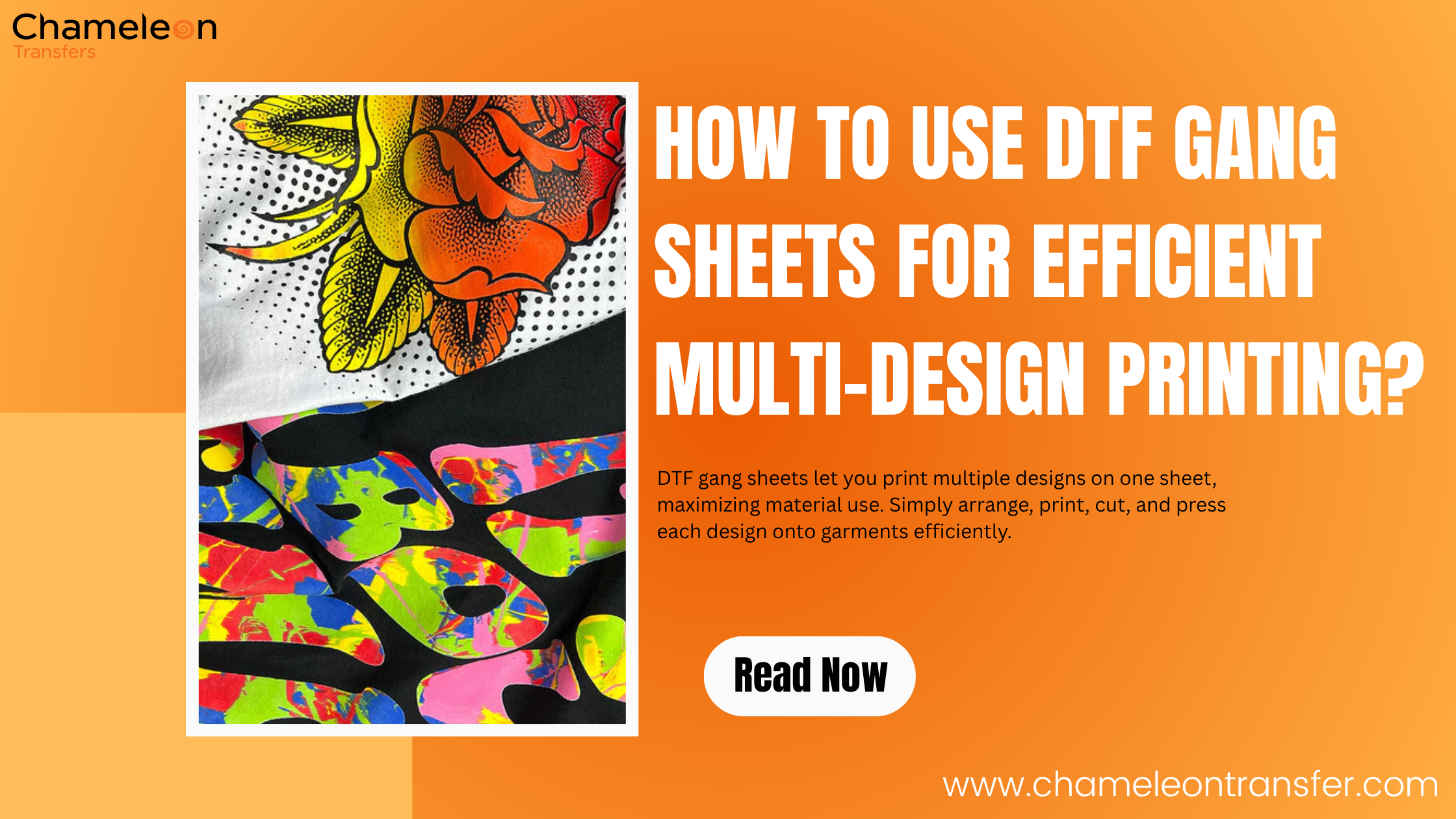Direct-to-Film (DTF) Printing is taking up the world of custom apparel and beyond, offering a fresh, versatile way to bring designs to life. This technique, often called DTF transfer, uses a DTF printer to print designs onto a special film, which is then transferred to fabrics, decor, or even hard surfaces like wood or metal using a heat press transfer method.
If you’re a business owner making unique T-shirts or an artist creating stunning art, DTF printing opens up exciting possibilities. But it’s not without its challenges.
Let’s dive into what makes DTF printing special, explore its key advantages, highlight its drawbacks, and compare it to other methods like DTF vs DTG and DTF vs sublimation.
Overview of Direct-to-Film (DTF) Printing
So, what is Direct-to-Film (DTF) Printing? At its core, it’s a process where a direct-to-film printer prints a design onto a film coated with a film and powder adhesive. This film is then sprinkled with adhesive powder, cured and pressed onto a surface, for example, T-shirts, hoodies, bags, or even non-fabric items, using a direct to film heat transfer printer. The result? A vibrant, durable design that sticks securely.
Unlike direct-to-garment (DTG) printing, which applies ink directly to fabric, DTF transfers offer incredible flexibility in garment compatibility. You can use a DTF printer, like the Procolored DTF printer or Epson 8550 DTF printer, to create print transferable designs that work on cotton, polyester, nylon, leather, and blends, no matter the color.
It’s a straightforward process: design, print, cure, and transfer. This makes DTF printing near me a go-to for businesses and creators looking to produce high-quality, custom products with ease.
Why DTF Printing Stands Out?
1. Works on Almost Anything
One of the biggest reasons DTF printing is so popular is its versatility. Contrasting sublimation vs DTF, where sublimation is limited to polyester and light-colored fabrics, DTF transfers can stick to nearly any surface, cotton, polyester, nylon, leather, wood, or even glass.
This garment compatibility makes it perfect for creating everything from custom apparel to unique home decor. Whether you’re using a blueprint printer, a transfer printer, or a best DTF printer like the Epson 8550 DTF printer, you’ll get consistent results across a wide range of materials.
2. Eye-Catching, Beautiful Designs
When it comes to print quality, DTF printers deliver stunning results. Using specialized DTF ink types, like CMYK and white pigment inks, they produce sharp, colorful designs that pop, even on dark fabrics. The white ink creates a solid base, ensuring your designs stay bold and clear.
While differentiating between DTF vs DTG printing, DTF often offers crisper details and better color accuracy for complex designs, like logos or photos. This makes it a favorite for apparel printers aiming for professional-grade results.
3. Cost-effective for Small Batches
For small businesses or custom orders, DTF printing is a cost-effective choice. Contrasting silk screen printing, which requires expensive setup for each design, DTF transfers skip the need for screens or pre-treatments, keeping costs low.
The DTF printer price is also approachable, with models like the Procolored DTF printer or the best DTF printer starting at a few thousand dollars. Plus, DTF transfers can be pre-printed and stored, ready to apply whenever needed, saving time and money for small runs.
4. Made to Last
DTF prints are tough. Thanks to the film and powder adhesive, designs can withstand 60 wash cycles without cracking or fading, making them ideal for items like sportswear or workwear.
When finding out the difference DTF vs DTG, direct-to-garment printers may produce softer prints, but DTF wins for durability, especially on demanding fabrics. This reliability makes it a top pick for customers who want long-lasting products.
5. No Pre-Treatment Hassles
When using direct-to-garment printing, which often requires pre-treating fabrics to ensure ink sticks, but DTF printing skips this step entirely. This saves time and reduces costs, making it easier for beginners to jump in.
The heat press transfer method, available in cold peel vs hot peel DTF options, keeps the process simple, so even small shops can produce professional results with minimal effort.
6. Flexible for Any Workflow
DTF printing gives businesses the freedom to pre-print transferable designs and store them for later use. This is a huge advantage for made-to-order businesses or those handling diverse products. Whether you’re working with a direct-to-transfer printer or a blueprint printer, DTF transfers let you scale production without committing to large inventories upfront.
Also Read: DTF Heat Press Settings: Optimize Your Machine for Best Results
Where DTF Printing Falls Short?

1. Upfront Costs Can Sting
While DTF printing saves money in the long run, the initial investment can be a challenge. A quality DTF printer, like the Procolored DTF printer or Epson 8550 DTF printer, depending on features.
Add in supplies like DTF ink types, PET films, and adhesive powders, and the startup costs can add up. For small businesses or hobbyists, this might be a barrier compared to cheaper options like sublimation vs DTF.
2. Maintenance Takes Effort
DTF printers need regular care to stay in top shape. White ink, a key part of DTF printing, can clog print heads if not maintained properly, as noted in many DTF printer reviews.
Businesses need to clean the printer regularly and control environmental factors such as temperature and humidity. This requires some technical know-how, which can be a learning curve for new users of a direct-to-film printer.
3. Texture Trade-Offs
When distinguishing DTF vs DTG printing, DTF prints can feel a bit stiffer due to the film and powder adhesive. This slight plastic-like texture might not suit lightweight or soft fabrics, like those used for cozy T-shirts.
Direct-to-garment printers often produce softer, more breathable prints, which could be a better choice for comfort-focused apparel. Customers sensitive to texture might notice the difference.
4. Environmental Impact
DTF printing relies on PET films and adhesive powders, which aren’t always recyclable, raising concerns for eco-conscious businesses. Compared to DTF vs sublimation, where sublimation uses water-based inks and generates less waste, DTF may not be the greenest option.
5. Not Ideal for Massive Orders
While DTF printing is great for small to medium runs, it can be slower for large-scale production compared to silk screen printing. The method of printing, curing, and transferring each DTF transfer takes time, which can add up for bulk orders. Businesses with high-volume needs might find other methods more efficient.
Comparing DTF to Other Printing Methods

-
DTF vs DTG
When looking at DTF vs DTG printing, DTF offers greater garment compatibility and durability, while DTG excels in producing soft, breathable prints. DTF doesn’t require pre-treatment, saving time, but DTG might be better for lightweight fabrics where comfort is key. Both are great for small runs, but DTF pulls ahead for versatility across materials.
-
DTF vs Sublimation
In the DTF vs sublimation debate, DTF wins for its ability to work on any fabric color and a wider range of materials. Sublimation is limited to polyester and light colors, but it is more eco-friendly and produces softer prints.
If sustainability or budget is a priority, DTF is better than sublimation, depending on your specific needs. DTF for flexibility, sublimation for eco-conscious projects.
Final Thoughts: Is DTF Printing Right for You?
Direct-to-Film (DTF) Printing versatility, cost-effectiveness for small runs, and high-quality output make it a standout choice, whether you’re using a Procolored DTF printer, an Epson 8550 DTF printer, or another best DTF printer.
However, the upfront DTF printer price, maintenance needs, and environmental concerns are worth considering. By weighing these pros and cons against alternatives like DTF vs DTG or DTF vs sublimation, you can decide if DTF printing aligns with your goals. For those ready to bring their ideas to life, DTF offers a world of creative possibilities.
At Chameleon Transfer, we specialize in turning your ideas into vibrant, wearable art, stunning wall decor, and more through our diverse range of high-quality printing services, including DTF printing.
Our mission is to provide exceptional service, unparalleled product quality, and innovative solutions tailored to your unique needs. Ready to create something extraordinary with a direct-to-film printer?
Visit us now to explore our DTF printing services and start your next project today!
FAQs
1. What are the main benefits of Direct-to-Film (DTF) printing?
DTF printing offers vibrant colors, durability, and versatility on various fabrics. It’s cost-effective for small batches, easy to use, and produces professional custom t-shirts with detailed graphics on t-shirt.
2. What are some drawbacks of using DTF printing?
DTF printing requires a specialized printer and T-shirt press machine, which can be costly. The process involves multiple steps, and improper curing may affect quality. Not ideal for very large runs.
3. What is Direct-to-Film (DTF) printing and how does it?
DTF printing prints designs onto film, coated with adhesive powder, then cured. The film is pressed onto a t-shirt with a T-shirt press machine, transferring vibrant custom t-shirt designs that are durable.
4. Can an Epson 15000 be used for DTF?
Yes, the Epson ET-15000 can be converted for DTF printing with DTF ink, a RIP software, and a modified printhead. It’s a popular choice for custom t-shirt printing at home due to its wide-format capability.
5. Is direct to film good quality?
Yes, DTF printing delivers high-quality, vibrant custom graphic tees with sharp details and durability. It rivals screen printing and works on various fabrics, making it ideal for custom made t-shirts.
6. Does direct to film printing last?
DTF printing is highly durable, lasting through many washes if applied correctly. Use quality custom t-shirt materials, proper curing, and care (wash inside out, cold water) to ensure custom printed shirts stay vibrant.
Also read more related blogs:
DTF Heat Press Settings: Optimize Your Machine for Best Results







